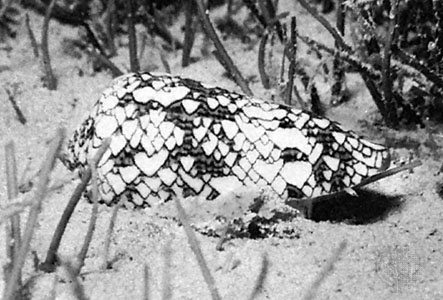cone shell
marine snail
 any of several marine snails of the subclass Prosobranchia (class Gastropoda) constituting the genus Conus and the family Conidae (about 500 species). The shell is typically straight-sided, with a tapering body whorl, low spire, and narrow aperture (the opening into the shell's first whorl). Cones inject a paralyzing toxin by means of a dart; a few of the larger species have fatally stung humans. The usual prey are worms and mollusks; a few capture fish. The various cone shell toxins are designed to interfere with a victim's nervous system and work by binding to specific cell surface receptors (glycoproteins) and ion channels. Cone shell toxins are widely used by neurobiologists to study receptor and ion channel functioning in vertebrates. Most cone species occur in the Indo-Pacific region.
any of several marine snails of the subclass Prosobranchia (class Gastropoda) constituting the genus Conus and the family Conidae (about 500 species). The shell is typically straight-sided, with a tapering body whorl, low spire, and narrow aperture (the opening into the shell's first whorl). Cones inject a paralyzing toxin by means of a dart; a few of the larger species have fatally stung humans. The usual prey are worms and mollusks; a few capture fish. The various cone shell toxins are designed to interfere with a victim's nervous system and work by binding to specific cell surface receptors (glycoproteins) and ion channels. Cone shell toxins are widely used by neurobiologists to study receptor and ion channel functioning in vertebrates. Most cone species occur in the Indo-Pacific region.The most valuable shell in the world—fewer than 100 specimens are known—is found on the glory-of-the-seas cone (C. gloriamaris) of the Philippines and Indonesia; 10 to 13 cm long, it is golden brown, with a fine net pattern.
- Colin Johnson
- Colin Macfarquhar
- Colin Maclaurin
- Colin Muset
- Colin Powell
- Colin Thubron
- collaborative software
- collage
- collagen
- collard
- collared lizard
- collective bargaining
- collective behaviour
- collective model
- collective security
- collective unconscious
- collectivism
- collectivization
- Colleen Dewhurst
- Colleen Moore
- college
- College football national champions
- College of Arms
- College of Charleston
- College of New Jersey